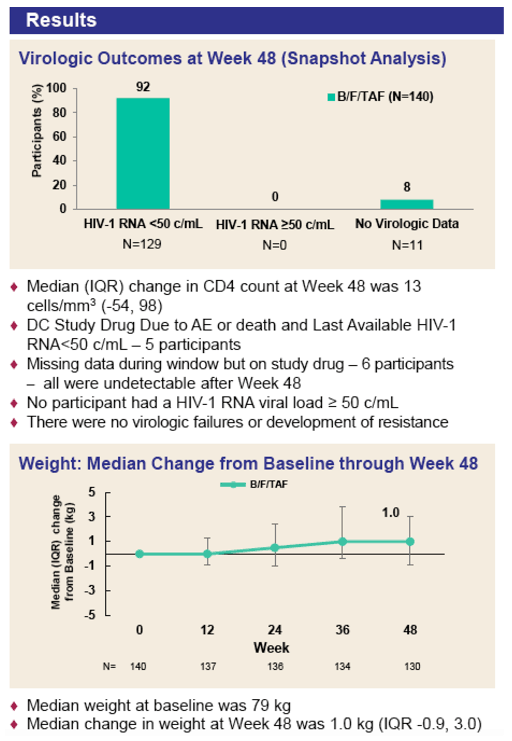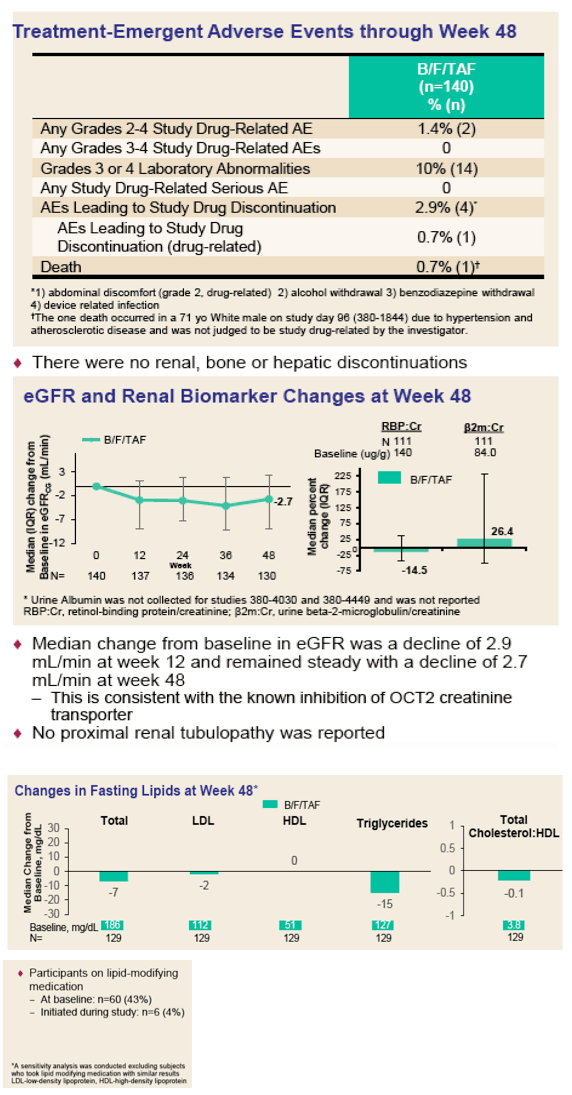 |
 |
 |
| |
Bictegravir/FTC/TAF Effective at 48 Weeks in Elderly: 4-Trial Analysis
|
| |
| |
11th International Workshop on HIV & Aging Virtual Meeting, September 30 to October 2, 2020
By Mark Mascolini for NATAP and Virology Education
Bictegravir plus emtricitabine (FTC) and tenofovir alafenamide (TAF) (B/F/TAF) controlled HIV well over 48 weeks in a four-study analysis of people switching to this single-tablet combination at age 65 or older [1]. One of 140 people stopped B/F/TAF because of a drug-related adverse event.
As the average age of people with HIV continues to climb, clinicians look for safe, effective antiretrovirals suitable for older individuals. Researchers who studied the integrase inhibitor bictegravir, and the drug's developer Gilead Sciences, proposed that B/F/TAF stands out as one option for aging people with HIV because of its convenient one-tablet-daily dosing, a low rate of drug-drug interactions, and a high barrier to HIV resistance.
To explore B/F/TAF efficacy and safety in people 65 and older, these researchers pooled results of four international trials (studies 1844, 1878, 4030, and 4449) in which patients with an undetectable viral load on a stable regimen switched to B/F/TAF. Everyone had a viral load below 50 copies in the two visits before screening for their B/F/TAF trial, and everyone had an estimated glomerular filtration rate (eGFR) at or above 30 mL/min.
The 140 pooled participants had a median age of 68 (range 65 to 80), 14% were women, 88% white, 12% black, and 14% Hispanic. Median CD4 count stood at 629 (range 132 to 1471), median weight at 79 kg (range 49 to 131), and median eGFR at 74 mL/min (range 38 to 130). Two thirds of the group took an integrase inhibitor regimen just before starting B/F/TAF, 29% took a protease inhibitor, and 4% took a nonnucleoside. When they entered their trial, more than half of participants had abnormal lipids (59%) or hypertension (55%), while substantial fractions had cardiovascular disease (24%) or diabetes (22%), and 18% smoked.
After 48 weeks of B/F/TAF, FDA snapshot analysis determined that 92% (129 people) had a viral load below 50 copies, the primary endpoint of this analysis. Of the remaining 11 people, 6 had missing virologic data but were still taking B/F/TAF and 5 had stopped the combination because of an adverse event when they still had a viral load below 50 copies. There were no virologic failures through week 48.
Median CD4 count rose by 13 cells over 48 weeks (interquartile range [IQR] -54 to 98), and median weight climbed only 1.0 kg (IQR -0.9 to 3.0). In 48 weeks total cholesterol dropped by a median 7 mg/dL, "bad" low-density lipoprotein cholesterol by 2 mg/dL, and triglycerides by 15 mg/dL. Median "good" high-density lipoprotein (HDL) cholesterol did not change in that time. Total-to-HDL cholesterol ratio remained virtually unchanged (down 0.1). Sixty people (43%) took a lipid-lowering drug when they started B/F/TAF, and 6 (4%) added a lipid drug during 48 weeks.
Four people (2.9%) stopped B/F/TAF because of an adverse event (grade 2 drug-related abdominal discomfort, alcohol withdrawal, benzodiazepine withdrawal, and a device-related infection). Two people (1.4%) had a grade 2 drug-related adverse event; no one had a grade 3 or 4 drug-related adverse event. There were no drug-related serious adverse events. Fourteen people (10%) had a grade 3 or 4 lab abnormality. No one stopped B/F/TAF because of kidney, bone, or liver problems. Estimated glomerular filtration rate fell (got worse) by a median 2.7 mL/min through week 48 but appeared to be stable since week 12.
Reference
1. Ramgopal M, Maggiolo F, Ward D, et al. Bictegravir/emtricitabine/tenofovir alafenamide (B/F/TAF) in adults aged >65 or older demonstrating safety and efficacy: week 48 results. 11th International Workshop on HIV & Aging Virtual Meeting, September 30 to October 2, 2020. Abstract 13.



|
| |
|
 |
 |
|
|